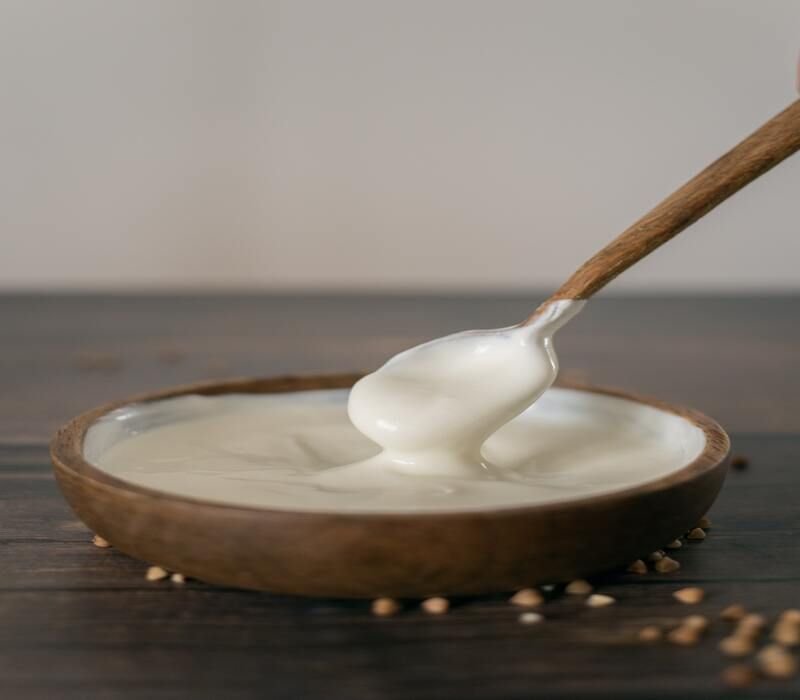The flavor of organic cream cheese is mild and fresh. It is made without the use of GMOs, hormones, or antibiotics and exclusively uses organic ingredients.
Straight from the refrigerator, the fresh cheese is spreadable. It tastes well in wraps, toast, crackers, and sandwiches. Additionally, it works well in baking, frying, and dipping.
If you like sour cream cheese and you want low-fat sour cream then you should read my article “low-fat sour cream “. It may help you.

Page Contents
Directions to Store Organic Cream Cheese
Be sure to keep cold. Up until the date stated on the front of the packaging, unopened packages are guaranteed to be fresh. Use, Within three to five days after opening.
Organic Cream Cheese Recipes
CREAM CHEESE WITHOUT RAW MILK
How to create cream cheese with organic whole milk if you don’t have a raw source of milk.
Ingredients
- Organic Pure Milk
- Vinegar
- Sea salt
- Buttermilk
Directions to Make
- 4 cups of organic pure milk should be heated to 90 degrees Fahrenheit in a small saucepan over low heat
- Add 2 teaspoons of organic whole milk and 1/2 tsp of white vinegar if you don’t have buttermilk. Also, add 1/2 tsp of unrefined sea salt and 2 tablespoons of buttermilk. Stir and leave for five to ten minutes. Currently, you have buttermilk
- The milk mixture should be placed in a glass half-gallon Mason jar with a strong grip. Until the milk has clabbered, turn the jar on its side and let it out at room temperature for several hours or overnight. It will be thick and have a gelatinous or yogurt-like appearance
- When the milk has clabber, whisk carefully while heating the mixture to 120°F, at which point it should begin to curdle. After 10 minutes, turn off the heat and leave the lid on.
- Now put the milk in a jelly strainer, a flour sack, a tea towel, or four layers of cheesecloth. Before adding the milk, thoroughly rinse each of these choices with cool water. My method is a jelly strainer. Allow for many hours of straining. The cream cheese will become thicker the longer you let it strain
- Never discard the liquid whey. It may be used to soak grains or oats or in smoothies. Real liquid whey is used in a lot of recipes. It’ll be kept in the refrigerator for up to 6 months. That is it, that simple!
MAKING CREAM CHEESE WITH NON-SOURED RAW MILK HASN’T
- 4 cups of milk should be heated in a small pan over low heat until it reaches 90 degrees
- Add 2 teaspoons of buttermilk and 1/2 teaspoon of unrefined sea salt. If you don’t have buttermilk, just combine 2 tablespoons of raw milk with 1/2 teaspoon of white vinegar in a small bowl. Stir and leave for five to ten minutes. Currently, you have buttermilk
- Fill a glass half-gallon Mason jar with the milk mixture, and then securely screw on the top. Lay the jar on its side and let it outside for 8 to 24 hours, or until the milk has clabbered, at room temperature. Since it is now quite chilly where I live, mine took more than 30 hours
- When milk has clumped, it will become viscous and have a gelatinous texture
- Transfer the milk to a jelly strainer, a thin flour sack, a thin tea towel, or cheesecloth once the milk has clabbered (layered about 4 times). My method is a jelly strainer
- Allow for up to 8 hours of straining at room temperature. Your cream cheese will have to be thicker the longer you let it strain
Organic Cream Cheese Nutrition Facts
| Nutrients Name | Amount Per Savings | % Daily Value |
|---|---|---|
| Total Fat | 10 gm | 13% |
| Saturated Fat | 6 gm | 30% |
| Trans Fat | 0 gm | |
| Cholesterol | 30 mg | 10% |
| Sodium | 100 mg | 4% |
| Total Carbohydrate | 2 gm | 1% |
| Dietary Fiber | 0 gm | 0% |
| Proteins | 2 gm | |
| Vitamin D | 0% | |
| Calcium | 2% | |
| Iron | 0% | |
| Potassium | 0% |
Horizon Organic Sunburst Cheesecake

Ingredients
- 1 1/2 cups graham cracker crumbs, cinnamon, or plain
- 1/2 tsp cinnamon
- 6 Tbsp organic unsalted butter (melted)
- 40 ounces cream cheese (room temperature)
- 1 2/3 cups sugar
- 1/4 cup flour
- 2 tsp vanilla
- 1 1/2 tsp freshly grated lemon, orange, or lime peel
- 6 large eggs
- 1/2 cup sour cream
- 1/2 Tbsp cornstarch or arrowroot
- 1/2 Tbsp organic unsalted butter
- 1/2 cup orange juice
- 1/3 cup each, fresh: sliced strawberries, blueberries, sliced peaches, sliced kiwis
Direction to Make
CRUST
- Combine the cinnamon and graham cracker crumbs
- Include melted butter. The 10-inch springform pan’s bottom and sides should be pressed in
FILLING
- The oven should be heated to 500 degrees
- Cream cheese should be properly blended by being beaten at a high speed in a big bowl
- Blend in vanilla, citrus peel, sugar, and flour completely
- One at a time beat thoroughly after each addition of an egg
- Stir in the sour cream. Pour over the raw crust. Bake for 12 minutes at 500 degrees
- Bake for a further 60 minutes at 200 degrees
- After turning off the heat, let the cheesecake cool in the oven for an hour
- After removing it from the oven, let the food l for 30 minutes before storing it in the refrigerator
- After covering and chilling for the night, top with fruit and glaze
ORANGE GLAZE
- In a small saucepan over medium heat set over medium heat, melt the butter
- Add cornflour or arrowroot by whisking
- Add orange juice and continually whisk as you come to a boil. 1 minute of boiling
- Until room temperature, cool. The cheesecake should be served with a spoon over the cooled fruit on top
Health Effects
Provides Antioxidants
Several carotenoids and antioxidants included in cream cheese work to combat damaging free radicals and avert oxidative stress and cell deterioration.
According to one study, antioxidants may also offer protection against inflammation in addition to chronic diseases including cancer, diabetes, autoimmune disorders, and heart disease.
Antioxidants are known to play a major role in both health and illness.
Tasty and Accessible
There are many more ways to incorporate this flavorful schmear into your diet in addition to spreading it over your bagel. It is creamy, rich, and full of flavor. In fact, this delectable ingredient enhances the texture of sauces, soups, and baked products and works in both sweet and savory meals.
To easily boost the flavor of your favorite foods, try adding it to mashed potatoes, pasta dishes, fruit tarts, or biscuits. For a straightforward vegetable dip, combine it with your preferred spices and herbs, such as dill, garlic, and chives.
Health Hazards of Organic Cream Cheese
This well-known food item has comparatively little protein and other critical components like vitamins and minerals compared to the number of cream cheese calories in each serving.
A greater variety of minerals, including phosphorus, calcium, and vitamin D, may be found in other dairy products like milk and cheese, which are also significantly richer in protein.
Contrarily, the low-fat cream cheese nutrition profile only has a little number of micronutrients like vitamin A and fewer than two grams of protein per serving.
Lastly, people with serious certain dietary limitations might not be able to eat cream cheese. For instance, although having a low lactose content, it isn’t recommended to be ingested by anyone who has a dairy allergy or who is on a dairy-free diet.
FAQs
The high quantities of calcium and protein found in ordinary cheese are also present in organic cheese. However, studies have shown that cheese made from certified organic milk has a far better nutritional value since cows are fed a natural diet consisting of grass-fed pasture.
As a result, cheese offers all the nutrients found in conventional milk in a tiny container while containing nothing in the way of carbohydrates. But cream cheese, which is made from cultured milk and cream and is fresh, is primarily a source of fat and calories.
Conclusion – Organic Cream Cheese
Although it may not be the healthiest option, some individuals just prefer organic cream cheese made from dairy.
If that describes you, incorporate complete plant fats like those found in avocado, olives, and almonds into your diet along with your cream cheese. To achieve balance, combine it with naturally nutrient-rich, unprocessed meals.
Here are some articles related to this topic you might want to read.


